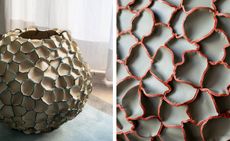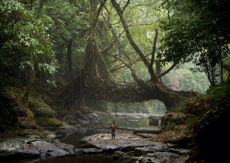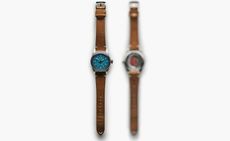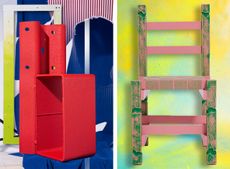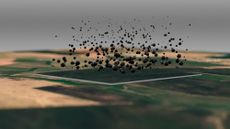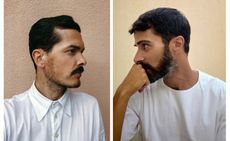Can synthetic biology solve the world’s problems?
Faber Futures, the pioneering London-based studio founded by Natsai Audrey Chieza, doesn’t just think about new approaches to form and material, but rather how to reshape the world of things from the ground up
- (opens in new tab)
- (opens in new tab)
- (opens in new tab)
- Sign up to our newsletter Newsletter
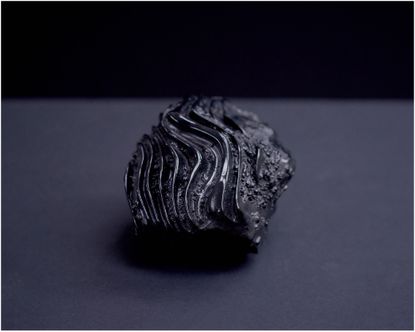
We are a society consumed by consumption, driven to preserve the economic status quo at all costs. Natsai Audrey Chieza and her studio Faber Futures are advocates for a different approach. As designers, researchers, strategists and storytellers, Faber Futures believes design has the power to make things better. And not just by making things, but by helping restructure our social and economic systems from the ground up.
Natsai Audrey Chieza and Faber Futures

Natsai Audrey Chieza.
Born in Harare in Zimbabwe, Chieza arrived in the UK at the age of 17. After studying architecture at the University of Edinburgh, she took an MA in Material Futures at Central Saint Martins before setting up Faber Futures in London in 2018. The studio, including lead strategist Laura Emily Vent, art director Camille Thiéry, design lead Ioana Man (opens in new tab) and design researcher Magdalena Obmalko, are uniquely placed to reshape the conversation in a world screaming for change.
‘When I started the company, it was just me and I was working with a single client, a synthetic biology start-up,’ Chieza recalls. ‘I was very much focused on trying to help them think about sustainability. If you can design and programme living cells to have specific functions, then of course that’s a really interesting technology. What matters more is what you are going to do with it.’
Faber Futures arose out of this desire to shepherd new technologies into the world without inadvertently replicating or reinforcing archaic systems and structures. ‘We began in the cultural sector, in institutions like galleries and museums, where we could be provocative about future materials and technologies,’ she explains. ‘I think where we are now is moving beyond the provocation, because society is shifting its expectations about the future, and how we manage our resources with climate change.’
‘If you can design and programme living cells to have specific functions, then that’s an interesting technology, but what matters more is what you are going to do with it'
It’s not just a social shift; financial institutions are waking up to the challenges. ‘We’re entering what we like to call in the studio a “doing space”, going beyond the speculation, beyond the strategising. Now is the time to actually implement these ideas in a very tangible way.’
Designing to shape a more equitable future

Innovation does not necessarily go hand in hand with a wholesale reappraisal of the systems that govern, guide and stimulate our consumption-driven lives. One of the transparently obvious joys of technology is a constant expectation of novelty and improvement as things get faster, smaller, sleeker, cheaper, shinier, cleverer. This system works just fine if you’re at the top of the tree and can’t see – or don’t care about – the detritus and waste tumbling down to the ground to rot. To continue the metaphor, this rot is finally and undeniably affecting the roots. Climate change is coming and many current practices, from making and shipping to buying and discarding, are no longer sustainable in their current form.
Faber Futures’ work is twofold. Not only is the studio involved with the business of ‘engineering microbes to do industrially useful things’, says Chieza, but it also wants to ‘build new models and institutions that are ahead of the game and mitigating against inequity’. This approach begins by challenging preconceptions. ‘If we want to shape future markets for products derived from biotechnologies, we need to start that work now, because in ten years’ time, these technologies are going to start coming into their own. We are priming for a time where things can be implemented at scale and have a much broader impact.’

A pigment specimen extracted from Streptomyces coelicolour that contains a DNA-encrypted label of the project’s meta data. Donated to the Forbes Pigment Collection’s permanent collection at Harvard Art Museums. Faber Futures x Ginkgo Bioworks, 2018.
Back in 2017, even as Chieza was urging her TED Talks audience to consider whether biology could really ‘fix’ the fashion industry’s pollution problem, the underlying message was the same: more equitable futures could only come out of new design frameworks. ‘I’m on the Global Future Council on Synthetic Biology at the World Economic Forum, and our remit is to outline the future of synthetic biology,’ she says. ‘We’re asking a fundamental question, which is, what if SynBio was based on principles of humility, solidarity, sustainability and equity? The Council is made up of a whole host of different people from leadership to academia. Faber Futures is coming in and saying that, actually, the cultural sector has a huge role to play in connecting what is on the molecular scale with the real world.’
The conflict and contradiction occur when these innovations simply perpetuate existing power dynamics and economic structures. For example, fast fashion. Faber Futures’ Project Coelicolor is a case in point. Starting with a wild strain of Streptomyces coelicolor, a soil-dwelling bacteria used in antibiotic production, the studio worked with Professor John Ward at the University College London’s department of biochemical engineering to explore whether the blue pigment it naturally secreted could be used as a textile dye. Ultimately, a colourfast finish was achieved without using excess water or industrial chemicals. Could such a ‘product’ be brought to the high street? It’s a challenge Faber Futures sets out to address. ‘Project Coelicolor has been in thoughtful development for the last ten years through cultural institutions, which is a really slow process,’ says Chieza. ‘If we shifted up a gear and moved beyond exhibition pieces that communicate the potential – very richly – and try to actually make it exist, what does the work become? What kind of start-up model could emerge from R&D with this legacy?’
New systems for creative leadership

From Project Coelicolor, ‘Assemblage 002’, a bacteria-dyed reversible silk coat created by Faber Futures in collaboration with Professor John Ward, Department of Biochemical Engineering, University College London, and commissioned by Cooper Hewitt Museum, 2019.
Chieza is pragmatic and practical. ‘We need to tone down the rhetoric that this is world-changing or revolutionary, because actually it isn’t.’ Most importantly, the gains made by SynBio and other biotechnologies will be blunted if they are just absorbed into existing systems. ‘You can engineer a yeast cell, for example, to produce a very specific commodity compound,’ she says. ‘We know how to ferment on an industrial scale – just look at beer. There are infrastructures and industries and brands who do just that. But the question we’re asking is, are those brands, companies and infrastructures fit for a world that is being changed by climate change? If the answer to that question is no, then perhaps just changing a single ingredient is not enough for us to see the change that we need.’
She cites another example. ‘It would be nice to clean up fast fashion’s supply chain. But the paradox is that their business model is based on consumption and infinite growth; it is totally unsustainable.’ Project Coelicolor could be brought to bear on the chemical-and water-intensive process of dyeing and yet, ultimately, all it would do is ‘shift the raw material from petroleum to sugar, if deeper systemic issues are left unaddressed’.

‘Transversal’ sculpture featuring Streptomyces coelicolor on silk. By Faber Futures in collaboration with Professor John Ward, Department of Biochemical Engineering, University College London, 2019.
So how can all these things be tackled? One answer is education. ‘We need designers who are capable of thinking and designing within very complex systems,’ says Chieza. ‘So what kind of education system is required for that? There is a pipeline for science PhDs to become start-up founders, but I also want to see these start-up founders coming out of more diverse institutions, such as Central Saint Martins. We need leadership from the creative sector.’ Chieza argues that designers have to think in a more entrepreneurial way.
Of course, there are also philosophical and moral issues at play. ‘How do you engage with something that culturally, in the most part, you’re trying to challenge? We have to engage with the system on some level.’ One of Faber Futures’ clarion calls is to elevate the arts and humanities to the same level of political importance as STEM subjects. ‘Including the design and creative industries within STEM is not a panacea, but it is currently missing in a fundamental way.’
The problem with design

Textiles being dyed with the bacterial pigment. Faber Futures x Ginkgo Bioworks, 2017
Above all, Chieza and her team believe that designers can and should expand their scope. In the modern era, ‘design’ has become culturally fixed as a commodity as opposed to a process. ‘If I think of my identity as a designer, it’s always been really difficult because I don’t make “stuff”, so I don’t often get featured in magazines that like to talk about stuff, she says. ‘Instead, I tend to speak to people who are interested in process and systems. Yet design has caused so many of the problems that we now face. The industry is slow to admit it and is waiting for someone else to figure it out.’ Chieza gives the example of big manufacturers who talk the talk yet wait for innovation to come their way. Instead, she says, they should be proactive and contribute their supply chain and manufacturing knowledge, helping, for example, the process of creating alternatives to leather, different dyeing processes or better recycling outcomes.
‘We have quite “sector agnostic” clients,’ she says, with a hint of frustration. ‘You would think that the design industry would be clamouring to cross-pollinate and work with scientific researchers and technologists, but they’re not. They’re just waiting.’
Likewise, as consumers, we are content to exist in a cycle of constant upgrades. We are kept supine by option paralysis, a situation that suits the status quo. ‘So far, we’ve only looked at sustainability through the lens of a society that is primed to be a consumer society and a consumer economy,’ says Chieza. ‘Our society is about trading commodities. But we have to look deeper. The question of sustainability is also about how we structure our global economies and supply chains, and whether or not resources are distributed equitably. Not just for consumers but for producers. Just providing the molecule that replaces toxic dyes is not going to be enough.’
Insert ‘You would think that the design industry would be clamouring to cross-pollinate and work with scientific researchers and technologists, but they’re not. They’re just waiting.’quote here
Faber Futures is talking about change on a molecular level and change on a society-wide level at the same time; fashion is simply a good place to start. Yet although we’re on the cusp of a biotechnological revolution, its potential could still be squandered if there aren’t radical shifts in the making, shipping, buying and disposing of goods. ‘Sustainable means lots of things, including how innovation and infrastructure have to be connected to jobs or marginalised communities,’ Chieza stresses. ‘These projects are not about product for product’s sake, but are a vehicle for different kinds of social and economic organisation. After all, what’s the point of having a bottom line for your shareholders if there’s no planet?’
INFORMATION
This article appears in the August 2021 issue of Wallpaper* (W*268), on newsstands and available for free download
natsaiaudrey.co.uk (opens in new tab)
faberfutures.com (opens in new tab)
Jonathan Bell has written for Wallpaper* magazine since 1999, covering everything from architecture and transport design to books, tech and graphic design. He is now the magazine’s Transport and Technology Editor. Jonathan has written and edited 15 books, including Concept Car Design, 21st Century House, and The New Modern House. He is also the host of Wallpaper’s first podcast.
-
 Cerith Wyn Evans: ‘I love nothing more than neon in direct sunlight. It’s heartbreakingly beautiful’
Cerith Wyn Evans: ‘I love nothing more than neon in direct sunlight. It’s heartbreakingly beautiful’Cerith Wyn Evans reflects on his largest show in the UK to date, at Mostyn, Wales – a multisensory, neon-charged fantasia of mind, body and language
By Harriet Lloyd-Smith • Published
-
 Nifemi Marcus-Bello is the Nigerian designer shaping Africa’s designscape
Nifemi Marcus-Bello is the Nigerian designer shaping Africa’s designscapeAmong Wallpaper’s ‘Future Icons’, Lagos-based designer Nifemi Marcus-Bello speaks of creating a local manufacturing network and documenting design production in Africa
By Ugonna-Ora Owoh • Published
-
 Luxury loungewear brands to hibernate in this winter
Luxury loungewear brands to hibernate in this winterAs days get shorter and temperatures drop, we present the best loungewear for luxuriating in this autumn and winter, from brands including Loro Piana, Raey, Extreme Cashmere and more
By Tilly Macalister-Smith • Published
-
 Liaigre ‘Upcrafted’ objects showcase potential of sustainable design
Liaigre ‘Upcrafted’ objects showcase potential of sustainable designStriding confidently towards more sustainable production, interior design company Liaigre has released ‘Upcrafted’, a series of limited-edition objects for the home, assembled attentively from the studio’s would-be waste
By Martha Elliott • Last updated
-
 Regenerative design: meet the creatives taking a rooting interest in learning from nature
Regenerative design: meet the creatives taking a rooting interest in learning from natureRegenerative design: meet the creatives taking a rooting interest in learning from nature
By Malaika Byng • Last updated
-
 No time for waste: Oris’ collaboration with a leather manufacturer recycles deer skins
No time for waste: Oris’ collaboration with a leather manufacturer recycles deer skinsDeer skins make for sustainable watch straps in a partnership between Oris and Cervo Volante
By Hannah Silver • Last updated
-
 Cooking Sections champions regenerative eating at the Serpentine’s The Magazine restaurant
Cooking Sections champions regenerative eating at the Serpentine’s The Magazine restaurantLondon-based artist duo Cooking Sections has created a menu of three dishes for The Magazine restaurant at Serpentine North, as part of the museum’s ‘Back to Earth’ programme featuring artistic responses to the climate emergency
By Sheila Lam • Last updated
-
 Best recycled designs from the Wallpaper* Design Awards
Best recycled designs from the Wallpaper* Design AwardsContemporary designers are using waste to create furniture designs that combine a distinctive aesthetic with a sustainable approach
By Anne Soward • Last updated
-
 Terra Carta Design Lab announces finalists
Terra Carta Design Lab announces finalistsHRH Prince Charles and Jony Ive, in collaboration with the Royal College of Art, announce the 20 finalists of the Terra Carta Design Lab
By Rosa Bertoli • Last updated
-
 Jony Ive’s LoveFrom unveils Terra Carta Seal design
Jony Ive’s LoveFrom unveils Terra Carta Seal designDesigned by Jony Ive to celebrate nature, with an intricate composition of flora and fauna, the Terra Carta Seal represents the charter’s values and will be bestowed upon private sector companies that distinguish themselves for their sustainability efforts
By Sarah Douglas • Last updated
-
 Formafantasma on their GEO-Design master’s programme, and designers thinking big
Formafantasma on their GEO-Design master’s programme, and designers thinking bigThe Italian design duo – and Designer of the Year in the 2021 Wallpaper* Design Awards – are among our featured visionaries in ‘5x5’, Wallpaper's 25th anniversary project. They discuss their first year heading the GEO-Design master’s programme at Design Academy Eindhoven, educating students for a changing world, and their pick of five creative leaders of the future who are expanding the practice of design
By TF Chan • Last updated



